SALTWATER CHRONICLES FLY FISHING ADVENTURES IN SALTWATER (part 14)
| Sysadmin Note |
|---|
| Part 13 can be found here |
Saltwater Game fish of the Florida
In this installment we will be covering spec's (Spotted Sea Trout), bluefish and Spanish mackerel these three are also very popular sport fish in the waters of Florida. All three of these species are highly popular with the fly fishing saltwater angler and all three are taken for table at times.
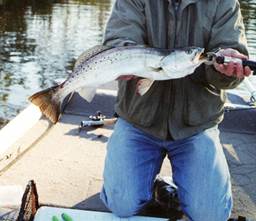
Spotted Sea Trout
Spotted Sea Trout [Cynoscion nebulosus] and the common names include spotted sea trout, spotted trout, spotted weakfish or just spec's, the larger ones are also called "Gator Trout". As a point of information the Indian River and the Sebastian Inlet area is noted for its large spotted sea trout called "Gator Trout". To be classed as a gator trout the fish generally exceeds six pounds.
The specs are often found in both brackish water and in coastal rivers along with saltwater estuaries and are found on sandy on sandy bottoms with Sea Grass and are often found around other structure such as docks. They will move to deeper water during the cooler months but rarely leave the estuaries where they were spawned.
Specs can attain thirty nine inches and a weight of eighteen pounds and can live up to fifteen years. They feed on shrimp and any minnows they can catch, the adults are generally solitary individuals but they also gather in small schools and feed in the shallows on the incoming tides. They are ambush predators who make swift short lunges to grab their prey with their front canine teeth prior to swallowing the prey whole.
The prefer water temperatures from the low 60's to the mid-80's degree and the spawning goes on from late March to September with the peak activity occurring during June to August. The spawning takes place at night and the fry hatch within eighteen hour of fertilization and hide in the bottom rubble for about six weeks when they move to the sea grass beds.
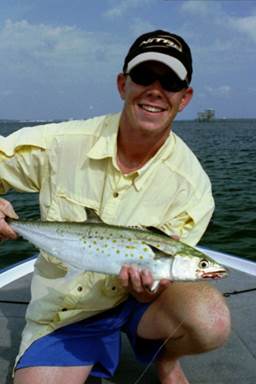
Atlantic Spanish mackerel
Spanish mackerel [Scomberomrus maculatus], and are also referred to as Spanish or macks. This toothy predator is found both inshore along the beaches in the inlets and estuaries and close off-shore.
They are a species that migrate in schools as the water temperatures rise beginning in South Florida in February and during the summer they move all the way up the coast to Cape Cod. The females can reach eleven pounds and can live for twelve years and the males live for about six years and seldom exceed twenty inches in length. They appear in large school and savage schools of baitfish.
The spawning in Florida occurs from July to September and the young often use the estuaries as nursery sites. In the saltwater almost everything is both prey and predator and the Spanish mackerel are both. They prefer water temperatures from 72 to 82 degrees and when the temperatures drop below 68 degrees they move to deeper water or move off-shore to warmer waters.
The Spanish mackerel is also a much sought after baitfish for a variety of big game sport fish species. But there sure are a fun fish with plenty of fight for the fly rod angler.
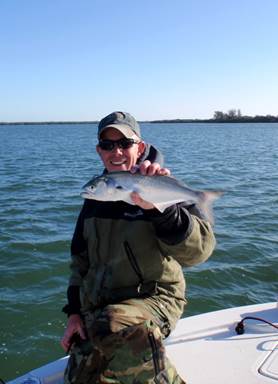
Bluefish
Bluefish [Pomatomus saltatrix] and also referred to as blues, snappers, sea wolf, choppers and slammer. The Bluefish is a popular gamefish and is good eating and they are known a various feeders and have a mouthful of knife edge teeth and the stories about their jaw strength and teeth are legendary!
As for feeding habits it is hard to name something they don't eat as they are known as ravenous feeders and they travel and feed in schools that are formed by fish of the same size as they will feed on smaller blues. Watching a feeding blitz is something to witness and hard to imagine unless you have seen it, they are most active during the hours of daylight. They are a very popular sport fish due to their strong runs and frequent jumps and often will bite off the angler who encounters them while fishing for other species.
They spawn off shore during the spring and fall, in Florida waters this means April and May on the east coast and October and November in the northern waters of the Gulf Coast. The fry hatch within forty eight hours of fertilization and upon hatching they migrate inshore to the estuaries and bays until they reach two to three pounds where they move to join the larger schools. Though they are primarily a saltwater species they can tolerate brackish water. They live an average of nine years and can reach forty pounds.
Along the west coast of Florida they average one to three pounds with some larger fish taken and off the east coast fish in the six to fourteen pound class are taken. Small bluefish are great table fare especially when eaten the same day that they are caught.
Now I will share some of the patterns that I use on these species, however these patterns are not species specific as these patterns will work on a variety of saltwater species and I will show you how one basic effective color scheme can be tied in a number of different styles to fit the conditions you are fishing.
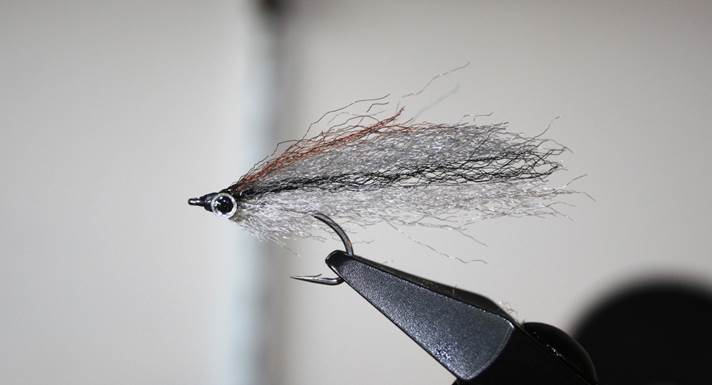
Anchovy Minnow
- Hook: Dai-Riki 930 Sizes: 2-8
- Thread: Light Dun 6/0
- Wing/Body: Silver/Grey EP Fibers with two strands of Silver Holographic Flash follow a very thin bunch of Black EP Fiber and then Gray EP Fibers and top with another thin bunch of 3D Brown EP Fibers
- Belly: White EP Fibers
- Eyes: 3 D Silver with Black centers applied with epoxy
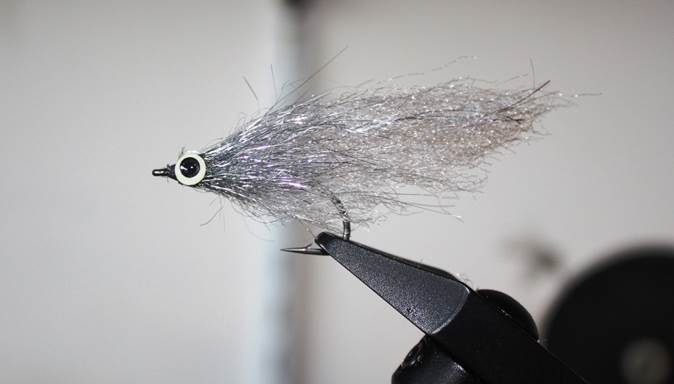
Silversides Minnow
- Hook: Dai-Riki 930 Sizes: 2-8
- Thread: Light Dun 6/0
- Wing/Body: Silver/Grey EP Fibers with two strands of Silver Flash-A-Bou topped with a thin bunch of Bronze EP Fibers and then another Bunch of Silver/Grey EP Fibers
- Belly: Silver/Grey EP Fibers
- Head: Silver Dubbing Brush
- Eyes: 3D-White with Black centers applied with epoxy
Now I will share with you one of the color schemes that I have used to catch all of the species covered in this installment and how by changing the style of the imitation it can be used to cover a variety of situations and species. The color scheme I have selected is the basic Yellow, Red, and Yellow.
Furthermore you can take any effective pattern and adapt it to the method or water type you are fishing here are six different styles using the same color scheme of Yellow-Red-Yellow.
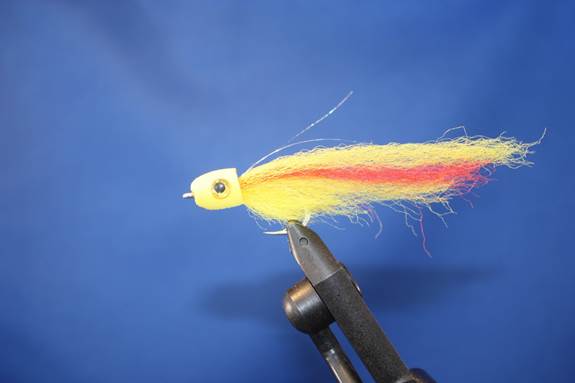
- Hook: Mustad 34007
- Sizes: 2/0 to 6
- Thread: Yellow 6/0
- Popper: Yellow Foam with 3D Yellow with Black centers, applied with epoxy. Many styles and shapes will work.
- Wing/Body: Yellow EP Fibers, Red EP Fibers with three to six strands of Silver Holographic with Yellow EP Fibers on top
- Belly: Yellow EP Fibers
This pattern is used on the surface.
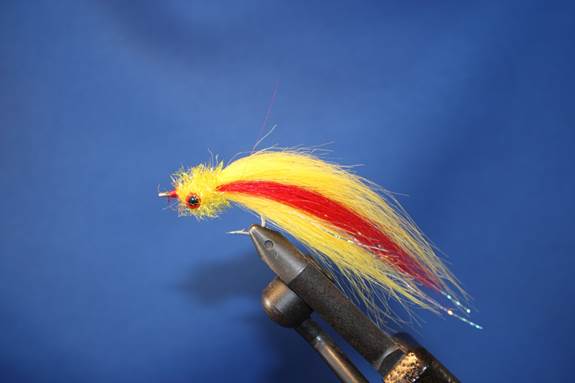
- Hook: Mustad 3407
- Sizes: 2/0 to 4
- Thread: Red 6/0 Tiemco 800S 2/0 to 4
- Wing/Body: Yellow Craft Fur, with six to eight strands of Silver Holographic Flash, with Red Craft Fur and topped with Yellow Craft Fur.
- Eyes: Dumb-bell types, painted Red with black centers, coated with Sally Hansen's Hard as Nail for durability
- Head: Yellow Estaz
This pattern is used in Deeper Water and I often use it in conjunction with a sink tip fly line.
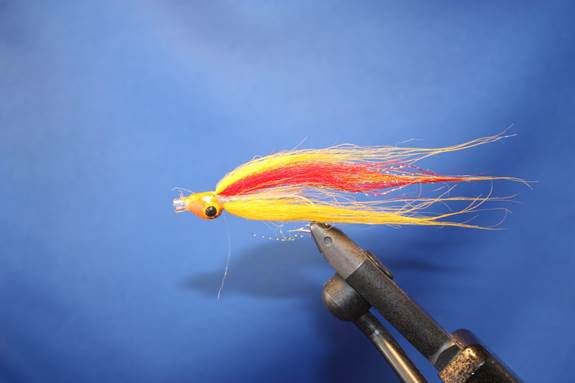
#3 Tube Style Craft Fur Clouser (Yellow-Red-Yellow)
There are several different tubes that could be used, various metal types but I use plastic tube, white or colored plastic tube from Q-tips, Clear Hard Plastic Tube all of which would need a snubber tube of soft plastic to hold the hook in position.
What I prefer is clear soft plastic tube which is found in any pet shop in the form of air line tubing for fish tanks or at any Medical Supply House where soft plastic tubing of various sizes may be obtained.
- Tube Size ¼ inch diameter Hook: Mustad 3407 Sizes: 1/0-2
Tube Size 9/64 inch diameter Hook: Mustad 3407 Sizes: 4,6,8
Tube Size 3/32 inch diameter Hook: Mustad 3407 Sizes: 8 - Eyes: Dumb-bell, painted Yellow with Black Centers, the eyes are tied on the top of the tube.
- Belly: Yellow Craft Fur
Now turn the tube over on the needle so the eyes are now on the bottom of the tube. - Wing: Red Craft Fur with six to eight strands of Rainbow Krystal Flash topped with Yellow Craft Fur
- Head: Coated with epoxy
I use tube flies for all types of imitations, tube flies are especially effective and durable on toothy predators.
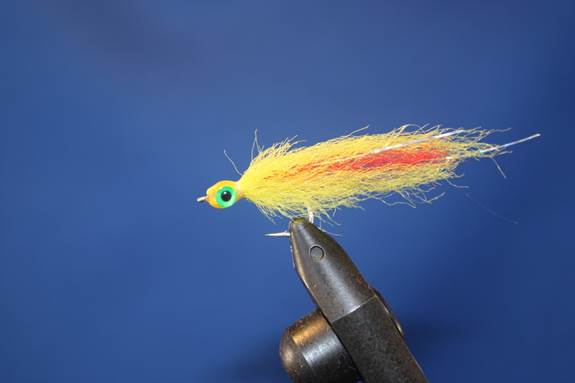
- Hook: Mustad 34007 Sizes: 1/0-6
- Thread: White A
- Wing/Body: Yellow EP Fibers followed by Red EP Fibers with 4 strands Silver Holographic Flash topped with Yellow EP Fibers
- Belly: Yellow EP Fibers
- Head: Yellow EP Fibers-top and bottom, tied bullet style
- Eyes: 3D Green with Black Centers applied with epoxy and also coat the head.
I use this pattern in shallow water on both floating lines and sink tips.
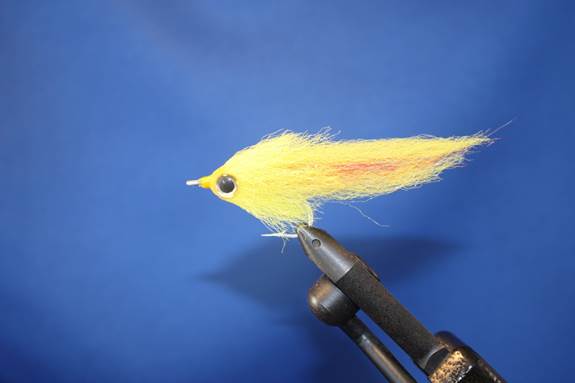
#5 Yellow & Red All Purpose Streamer
- Hook: Mustad 3407 Sizes: 4/0-6
- Thread: Yellow A Tiemco 800S 4/0-8
- Wing/Body: Yellow EP Fibers, Red EP Fibers with four strands of Silver Flash-A-Bou topped with Yellow EP Fibers
- Belly: Yellow EP Fibers
- Eyes: 3D Silver with Black Centers, applied with epoxy
Brush out and trimmed to shape. I use this pattern on larger gamefish on various types of fly lines.
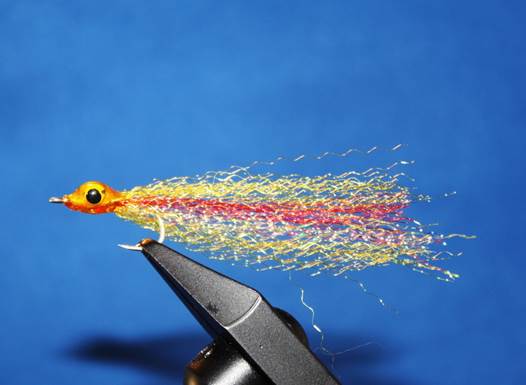
#6 Super Clouser Yellow-Red-Yellow
- Hook: Mustad 34007 Sizes: 1/0-8
- Thread: Clear Ultra Fine Mono
- Eyes: Dumb-bell type, painted Yellow with Black centers, tied on the top of the hook shank, this will cause the hook to invert and ride point up is the water
- Belly: Yellow Ultra Hair
- Wing: Red Ultra Hair, with eight to ten strands Rainbow Krystal Flash, topped with Yellow Ultra Hair
The effectiveness of Clouser Minnows is legendary and needs no further explanation.
So as you can see one color scheme can be used in several different patterns styles and all of the styles are effective.
Enjoy & Good Fishin'
| Sysadmin Note |
|---|
| Part 15 can be found here |
